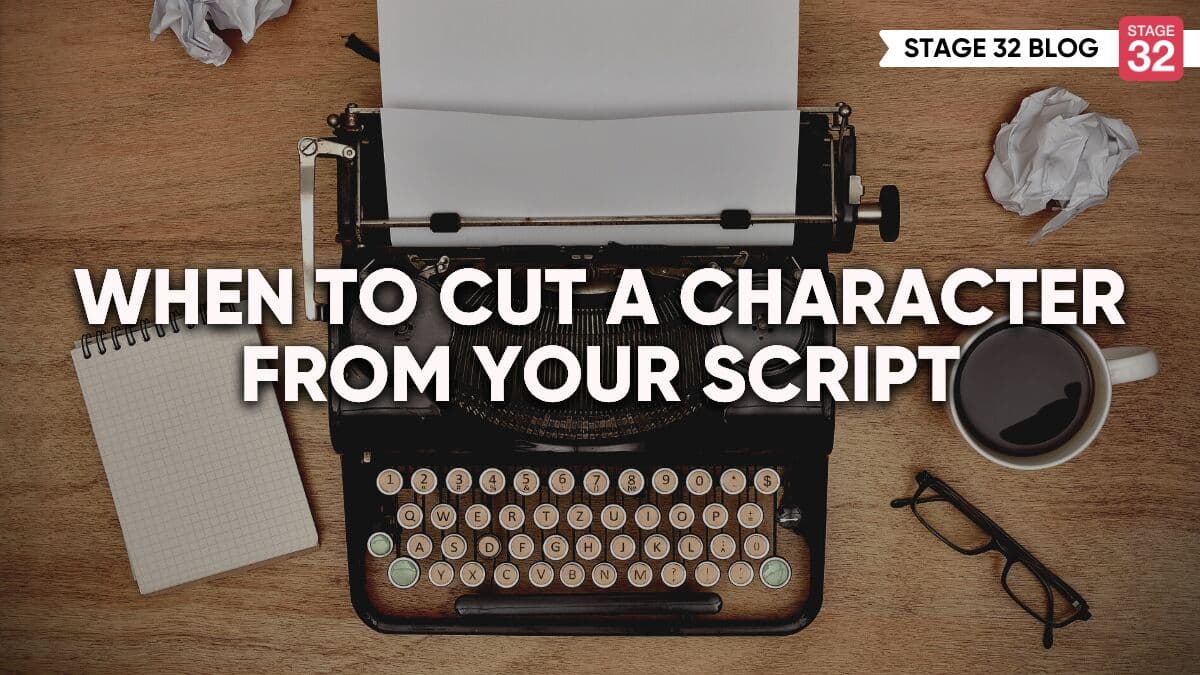When To Cut A Character From Your Script

When To Cut A Character From Your Script

As writers, we often hear the phrase, “kill your darlings.” But, that phrase is often in the context of cutting out writing or scenes that don’t work, slow down a piece, or are utterly unnecessary.
Recently though, I’ve found myself taking it another way. I’m one of those people who work on multiple projects at once, and two of the things I’m working on had a similar thing happen. I cut an entire character from both.
This can be more painful than cutting scenes or entire plot points. In both screenplays and novels, creating compelling characters takes time and effort; to suddenly and completely remove all traces of them hurts. In the case of a pilot script, you have to go back through the series bible and edit out any and all mentions of them. It’s like they never existed.
In my case, I cut a character out of a pilot script and a second out of a novel. Both were for different reasons and came with different results.
Let’s take a look at some of the reasons why I made the decision I did. Hopefully, it can help you when you face a similar situation.

When you budget a production, keep this in mind: every character in the script represents a person you will need to pay for every day they’re on set. When you’re working on a strict budget, it is something you especially have to consider as you write.
In a novel, however, budget isn’t an issue. But, no matter the genre, there is a flow to a story and an extra character can disrupt it.
That was one of the problems I faced in one of the books I’m currently working on. It’s a sequel to a previous story I wrote. But with this book, I’m establishing the world and creating a cast of characters that we will see book to book as I turn this into a series.
Without giving too much away, I created an assistant for my lead investigator and then created her best friend; I made them a duo of sorts. I figured the two could bounce off each other and bring different perspectives. I thought I had justified the friend’s existence by giving her a background in PR. My protagonist has gotten some not-so-great press and is in hot water; I thought that someone in her corner who knows how to massage a situation would be interesting.
As I developed the story, things weren’t clicking. Some problems were solved by cutting storylines from earlier drafts that I was hanging on to. Even so, issues persisted and it took me ages and the advice of my editor to figure out the problem.
That PR-expert friend did absolutely nothing to help the story. In fact, she was hurting it by her mere presence. Every time I brought her in, it bogged down and slowed down the story in a way that I didn’t quite catch (because I was too close to it).
Another character was solving problems and handling plot developments for my protagonist. It’s much more interesting when she has to do that for herself.
There’s a bonus tip for you: it’s almost always more interesting (and meaningful to their arc) when your protagonist(s) have to face adversity head-on.

I tried to keep her in a different or reduced role, but I eventually ended up cutting her entirely from the novel.
And sure enough, the story started to flow better. All those words that she took up could be better used elsewhere.
This leads me to my second cut character.
As you’ve seen in previous posts I’ve done for this site, I’m currently working on a pilot for a web series. I’ve been developing this show for a year now. Over the course of that year, I’ve been drafting the pilot episode as the world around the series took shape.
When it comes to television, I’m of the philosophy that people come for the premise but stay for the characters. With that in mind, when I write for the screen, I focus heavily on them. If they are well-developed, they’ll help carry the script.
In this case, the story formed around my lead character and began to develop. During earlier drafts, I wrote who I thought would be the male lead. He was going to work alongside my main character and eventually, I was considering allowing them to get together into a relationship.
But while my female protagonist worked, the guy did not. It became evident pretty quickly that part of the script’s problem was this character. While trying to fix him didn’t help, finally, I made the decision to cut him altogether.
And it worked. The script began to flow much more and another character stepped up to fill the hole he left behind. It made the script stronger, made the characters sharper, and moved the story along.

So, if you’re having issues with a story, let me leave you with some food for thought.
If you removed that character from the story entirely, would it make a difference?
In both of the cases I’ve mentioned above, the character’s absence didn’t negatively affect the story. With that in mind, it became obvious that the characters added nothing to the story.
From an editing perspective, the only logical course is to remove them.
This is one of those times when you truly need an editor or a second set of eyes. As writers, no matter whether it be for a book or for the screen, we often find ourselves far too close to our work to see things with any degree of objectivity.
But an outsider’s perspective can do so much to help strengthen a story.
Whenever you add a new character, especially in a script, you should ask yourself…
What purpose does this character serve?

As a mystery writer, I look at it in terms of the story. Do they deliver a vital clue? Are they the only ones who can give or get that information? Is it best coming from them?
If that’s a yes, perhaps they can stay, but maybe I’ll downgrade their importance to a little more than giving me that missing piece. Though in many cases, if there’s not another pre-existing character who can offer vital information, that missing clue would be best served by moving that plot reveal to physical evidence. It not only saves you the money you can use elsewhere, but it can also help bring your sets, props, or costuming alive.
For example, a protagonist could learn their dead family member was in debt by talking to a banker–or they could find crumbled-up IOUs in their family member’s jacket pocket and overdue notices stuffed out of sight in a drawer. The latter option breathes life into an otherwise unseen character and makes the world feel lived-in.
If a character truly is bogging down a story, chances are they serve no purpose that can’t be filled by someone (or something) else.
Trust me, I know firsthand how hard it is to cut scenes, much less entire characters. It feels like you’re killing off someone who barely got the chance to live. It can hurt.
As writers, our job is to make sure that our work is as strong as it can be.
That’s why the advice to Kill Your Darlings is so important. It may hurt in the short term, but you and your project will benefit from it in the long term.
Let's hear your thoughts in the comments below!
Got an idea for a post? Or have you collaborated with Stage 32 members to create a project? We'd love to hear about it. Email Emily at blog@stage32.com and let's get your post published!
Please help support your fellow Stage 32ers by sharing this on social. Check out the social media buttons at the top to share on Instagram @stage32 , Twitter @stage32 , Facebook @stage32 , and LinkedIn @stage-32 .
About the Author

Mary Helen Norris
Author, Editor, Marketing/PR, Screenwriter
M.H. Norris most recently launched her mystery series, All The Petty Myths, which combines forensics and mythology. The first volume featured the premiere story “Midnight,” which won #2 Best Mystery Novel in the 2018 Preditors and Editors Readers’ Poll. Other stories in the collection took home #1 S...





